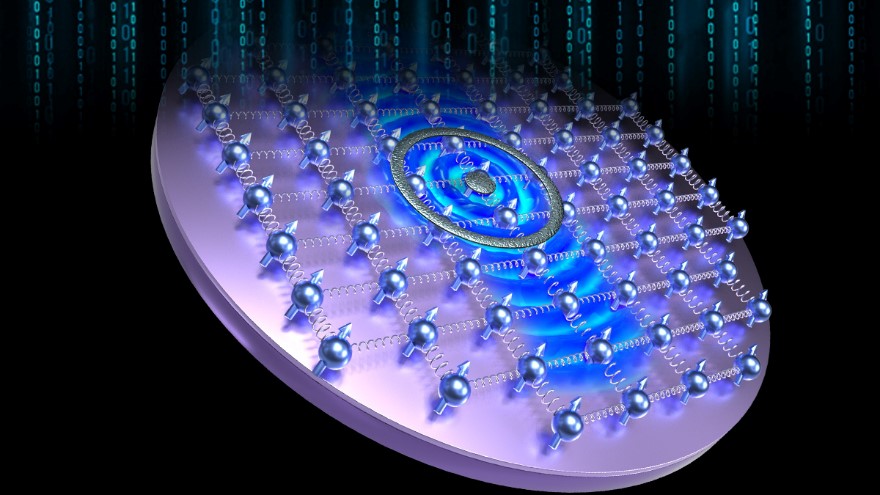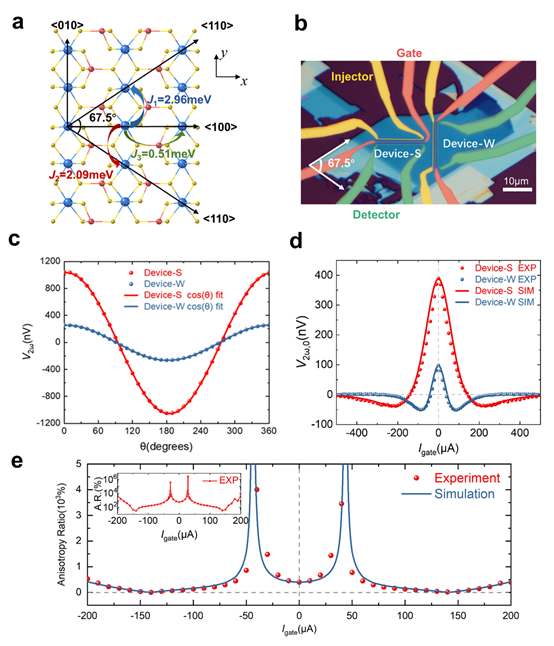Giant electrically tunable magnon transport anisotropy in a van der Waals antiferromagnetic insulator
2023/05/05

Recently, the In-situ Quantum Transport Group led by Prof. Jian-Hao Chen, in collaboration with the researchers from Peking University, Fudan University, Beijing Normal University and Sun Yat-sen University, discovered an electrically tunable anisotropy of magnon transport for the first time in the two-dimensional antiferromagnetic insulator CrPS4. And the researchers demonstrated multi-bit read-only memories (ROMs) where information is inscribed by the anisotropy of magnon transport. The related research paper titled “Giant electrically tunable magnon transport anisotropy in a van der Waals antiferromagnetic insulator” has been published in Nature Communications on May 2, 2023.
A lower symmetry in material system usually leads to anisotropy, which is of great interest in fundamental science and application researches. It is well-known that magnetic anisotropy is an important property of magnetic materials. Magnetic memory based on the magnetic anisotropy resistance effect is the basis of modern information technology. The recently discovered van der Waals magnets are a kind of low dimensional magnetic system, which is widely concerned because of its ordered magnetism in atomic-thin limit and highly tunable functional properties. For van der Waals magnets, the two-dimensional properties greatly enhance the effect of magnetic anisotropy. As a low-power information carrier, the quanta of spin wave, i.e. magnon in two-dimensional magnets, has important application potential in the future quantum enhanced information technology. However, the influence of the anisotropy of in-plane magnetic interaction on two-dimensional magnon transport is rarely studied.

Fig.1 Electrical tunable anisotropic magnon transport in CrPS4. a, In-plane atom arrangement indicating anisotropic magnetic exchange energies along the <100> and <010> direction. b, Optical micrograph of the devices. Device-S (Device-W) detects magnon transport along the strong (weak) magnetic exchange axis <010> (<100>), respectively. c, V2ω vs. angle θ between the external B field and the direction perpendicular to respective Pt electrodes for Device-S and Device-W. d, Experimental and simulated V2ω,0 vs. Igate curves. The 0 point (“off”state) appears at lower gate current for Device-W. e, Experimental data (dots) and simulation (solid line) of the gated anisotropy ratio Inset shows the experimentally realized giant electrically tunable anisotropy up to 2500000%.

Fig.2 Anisotropic magnon read-only memory (ROM). Left panels (a, c, e): Optical image of each CrPS4 anisotropic magnon read-only memory unit recording the letter “PKU” in ASCII codes. Right panels (b, d, f): operation of the magnon ROM with Iread =0μA (not reading) and 60μA (reading), respectively. When in the reading state, each magnon ROM unit generates an 8-bit series that represent a capital letter according to the ASCII codes.
Here, a two-dimensional antiferromagnetic insulator CrPS4 with in-plane magnetic exchange anisotropy is studied. As shown in Fig.1, the researchers discovered that thermal magnons propagating along crystal axes with different magnetic exchange intensities gives different magnitude of signals and different DC gate modulation responses. The thermal magnon transport in CrPS4 shows great electrically tunable anisotropy: the second harmonic signal of the magnon transport along the axis with weak magnetic exchange strength is also weak and can be adjusted to 0 (“off “ state) under a small gate current, while the second harmonic signal of the magnon transport along the axis with strong magnetic exchange strength is much stronger and can only be adjusted to 0 under a rather large gate current. The anisotropy ratio can theoretically be adjusted from 1 (isotropic) to infinity (anisotropic). Theoretical modeling found that 2D anisotropic spin Seebeck effect caused by the intrinsic in-plane magnetic anisotropy is the key to this gaint electrical tunability. Finally, by using such large and tunable magnon transport anisotropy, a new principle read-only memory is demonstrated and the reading of three letters of "PKU" encoded by ASCII code is displayed in Fig. 2. The work is the first time to observe large electrically tunable magnon transport anisotropy and unveils the potential of anisotropic van der Waals magnons for information storage and processing.
Dr. Shaomian Qi from Peking University and Dr. Di Chen from BAQIS are the co-first authors, and Prof. Jian-Hao Chen is the corresponding author of the above research. This work has been supported by the National Basic Research Program of China, the National Natural Science Foundation of China, and Beijing Municipal Natural Science Foundation.
Link of the publication: https://www.nature.com/articles/s41467-023-38172-7
 中文
中文 Email
Email QCloud
QCloud Log in
Log in
